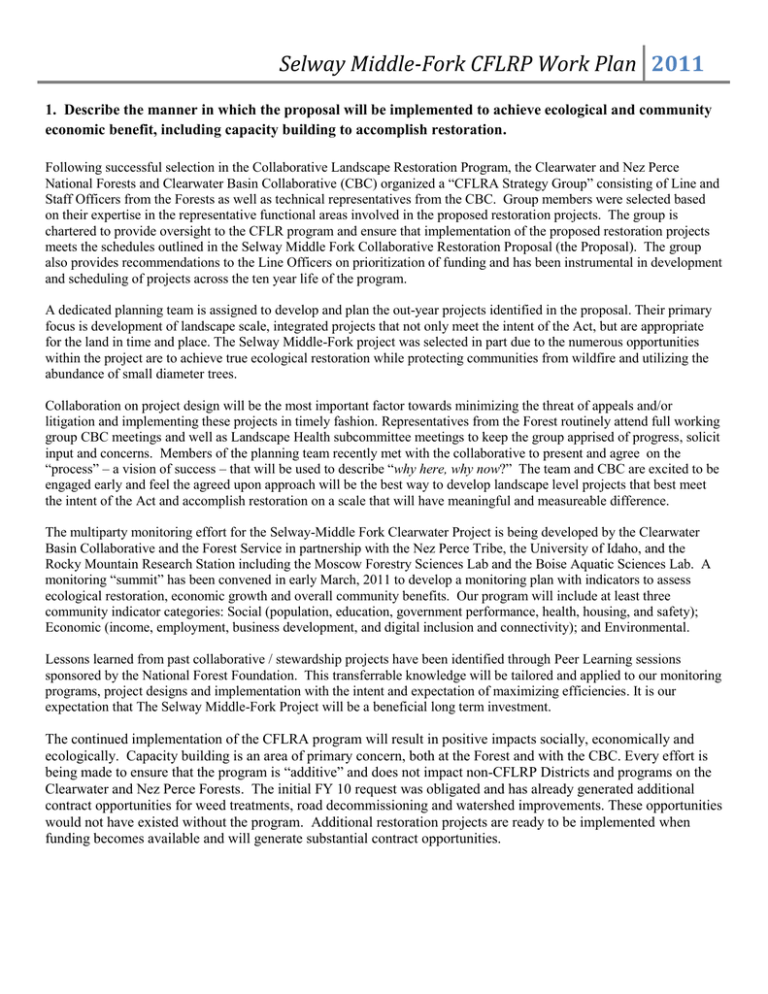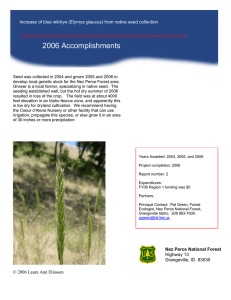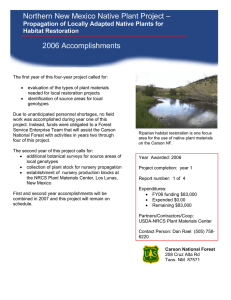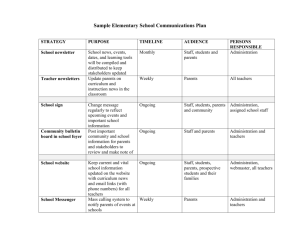Selway Middle-Fork CFLRP Work Plan 2011
advertisement

Selway Middle-Fork CFLRP Work Plan 2011 1. Describe the manner in which the proposal will be implemented to achieve ecological and community economic benefit, including capacity building to accomplish restoration. Following successful selection in the Collaborative Landscape Restoration Program, the Clearwater and Nez Perce National Forests and Clearwater Basin Collaborative (CBC) organized a “CFLRA Strategy Group” consisting of Line and Staff Officers from the Forests as well as technical representatives from the CBC. Group members were selected based on their expertise in the representative functional areas involved in the proposed restoration projects. The group is chartered to provide oversight to the CFLR program and ensure that implementation of the proposed restoration projects meets the schedules outlined in the Selway Middle Fork Collaborative Restoration Proposal (the Proposal). The group also provides recommendations to the Line Officers on prioritization of funding and has been instrumental in development and scheduling of projects across the ten year life of the program. A dedicated planning team is assigned to develop and plan the out-year projects identified in the proposal. Their primary focus is development of landscape scale, integrated projects that not only meet the intent of the Act, but are appropriate for the land in time and place. The Selway Middle-Fork project was selected in part due to the numerous opportunities within the project are to achieve true ecological restoration while protecting communities from wildfire and utilizing the abundance of small diameter trees. Collaboration on project design will be the most important factor towards minimizing the threat of appeals and/or litigation and implementing these projects in timely fashion. Representatives from the Forest routinely attend full working group CBC meetings and well as Landscape Health subcommittee meetings to keep the group apprised of progress, solicit input and concerns. Members of the planning team recently met with the collaborative to present and agree on the “process” – a vision of success – that will be used to describe “why here, why now?” The team and CBC are excited to be engaged early and feel the agreed upon approach will be the best way to develop landscape level projects that best meet the intent of the Act and accomplish restoration on a scale that will have meaningful and measureable difference. The multiparty monitoring effort for the Selway-Middle Fork Clearwater Project is being developed by the Clearwater Basin Collaborative and the Forest Service in partnership with the Nez Perce Tribe, the University of Idaho, and the Rocky Mountain Research Station including the Moscow Forestry Sciences Lab and the Boise Aquatic Sciences Lab. A monitoring “summit” has been convened in early March, 2011 to develop a monitoring plan with indicators to assess ecological restoration, economic growth and overall community benefits. Our program will include at least three community indicator categories: Social (population, education, government performance, health, housing, and safety); Economic (income, employment, business development, and digital inclusion and connectivity); and Environmental. Lessons learned from past collaborative / stewardship projects have been identified through Peer Learning sessions sponsored by the National Forest Foundation. This transferrable knowledge will be tailored and applied to our monitoring programs, project designs and implementation with the intent and expectation of maximizing efficiencies. It is our expectation that The Selway Middle-Fork Project will be a beneficial long term investment. The continued implementation of the CFLRA program will result in positive impacts socially, economically and ecologically. Capacity building is an area of primary concern, both at the Forest and with the CBC. Every effort is being made to ensure that the program is “additive” and does not impact non-CFLRP Districts and programs on the Clearwater and Nez Perce Forests. The initial FY 10 request was obligated and has already generated additional contract opportunities for weed treatments, road decommissioning and watershed improvements. These opportunities would not have existed without the program. Additional restoration projects are ready to be implemented when funding becomes available and will generate substantial contract opportunities. Selway Middle-Fork CFLRP Work Plan 2011 2. Anticipated unit treatment cost reduction over ten years: Performance Measure Code Average Cost Historic Reduction Unit Cost per Unit $1,375/Ac $0/Ac TMBR-SALES-TRT-AC $55/CCF $0/CCF $35/Ton $0/Ton $450/ac $0-250/ac $131/ac $0-50/ac TMBR-VOL-SLD BIO-NRG FP-FUELS-NON-WUI (Slash Burning) FP-FUELS-NON-WUI (Natural Fuels Burning) Assumptions Assumption: unit cost considers both appropriated expenditures and implementation cost/revenue. Cost savings are expected with NEPA efficiencies, implementation costs (prep & admin) remain static, and sale/project value decreases with small diameter low value material and higher logging costs. Assumption: unit cost considers both appropriated expenditures and implementation cost/revenue. Cost savings are expected with NEPA efficiencies, implementation costs (prep & admin) remain static, and sale/project value decreases with small diameter low value material and higher logging costs. Assumption: unit cost considers both appropriated expenditures and implementation cost/revenue. Bioenergy is a by-product that results from timber sale planning & implementation. Cost savings are expected with NEPA efficiencies, implementation costs (prep & admin) remain static, and sale/project value decreases with low value slash material and higher logging costs. Cost reduction potential is from bio-mass utilization. Cost may range from 0-$17/green ton depending on location and market demand. Additional cost reduction offset can be attributed to average gross stumpage of $10/green ton Cost reduction is based primarily on maintenance burning in previously treated areas. Fire resources needed for implementation may decrease due to modified fire behavior and Selway Middle-Fork CFLRP Work Plan 2011 FP-FUELS-NON-WUI (Fire for resource benefit) FP-FUELS-WUI INVPLT-NXWD-FED-AC RD-HC-MAIN RD-DECOM RD-PC-IMP RD-PC-MAIN RD-HC-IMP reduced holding concerns. $81 $0-50 Potential cost reduction near WUI areas from fuel treatments that modify fire behavior and the threat to values of concern. $550 $0-250 Cost reduction potential is from bio-mass utilization. Costs may range from 0-$17/green ton depending on location and market demand. Additional cost reduction offset can be attributed to average gross stumpage of $10/green ton $300 $150 Assumptions for unit cost reductions are twofold. Substantial initial investment will allow treatments on a scale to maximize effectiveness. Invassive populations will be able to be subsequently managed at a lower “maintenance” level, reducing cost per acre for treatments. Initial investment has also created additional contract opportunities and competition. $200$0One time investment up front to $500/mi $200/mi. address accumulated deferred maintenance needs yields reduced annual maintenance needs. $5000$5000Once decommissioned no further $15000/mi. $15000/mi. administration funding needed. $1000$1000One time investment up front to $30,000/mi. $2000/mi. address accumulated deferred maintenance needs yields reduced annual maintenance needs. $500$0One time investment up front to $1500/mi. $500/mi. address accumulated deferred maintenance needs yields reduced annual maintenance needs. $50$50One time investment up front to $10000/mi. $1000/mi. address accumulated deferred maintenance needs yields reduced annual maintenance needs. Selway Middle-Fork CFLRP Work Plan 2011 3. Anticipated costs for infrastructure needed to implement project: Type of Infrastructure Anticipated Cost Framing Our Community has several investment projects outside the project area (small business incubator that uses small diameter and standing dead wood to make wholesale and retail products that have a higher margin). Existing investment for Phase 1 is $363,297; and for Phase 2 is $535,230, $898,527 total; projected investment through 2010 is $642,500 for incubator expansion; $4 million for a combined heat system 2012 Workforce training center in Kamiah for in-woods machinery operations. $600,000 Workforce training center in Elk City to train people in bridge and dam construction in Wilderness; maintain and construct trails in Roadless and Wilderness areas $650,000 to build the facility 10 Megawatt biomass power facility in Orofino $10,000,000 for construction Funding Source (federal, private, etc) 50% federal and 50% state and private Partnership with Lewis and Clark State College to acquire money; initial investment (1/2 private; ½ federal); City of Kamiah donating 10 acres of property for facility. 50% federal and 50% state and private $550,000 for the curriculum, staff and instruction Funding is anticipated to be a mix of Federal, county and private. $140,000 of federal funding has already been awarded for the second phase of a feasibility study. Selway Middle-Fork CFLRP Work Plan 2011 4. Projected sustainability of the supply of woody biomass and small diameter trees removed in ecological restoration treatments: Fiscal Year 2010 2011 2012 2013 2014 2015 2016 2017 2018 2019 Number of acres to be treated 0 510 700 450 1,245 1,245 2,515 2,245 2,245 1,000 5. Projected local economic benefits Type of projects Total direct jobs Commercial Forest Products Other Project Activities TOTALS: 47.5 47.9 95.4 Projected Green Tons Removed per Acre 0 70 20 54 74 74 73 79 79 85 Total indirect jobs 93.3 20.6 113.9 Total Green Tons Available 0 35,750 13,750 24,250 91,500 91,500 184,500 176,500 176,500 85,000 Total Direct Labor Income $2,929,580 $2,066,457 $4,996,038 Total Indirect Labor Income1 $2,652,096 $670,837 $3,322,934 6. Document the non-Federal investment in the priority landscape: Source of Investment Amount of Investment Description of Use Nez Perce Tribe $2,000,000 annually Clear Creek and Selway hatchery operations; native and anadramous species restoration and monitoring. Selway Bitterroot $200,000 annually Trail maintenance and weed treatments Foundation Outfitters $45,000 annually Trail maintenance Volunteers $80,000 annually Trail maintenance and weed treatments Clearwater Basin $150,000 annually Collaboration Collaborative Idaho County $200,000 Fuelbreaks on private lands Idaho County $60k annually Firewise work Idaho County $629,000 FEMA work flood repair Idaho County $175,000 Road Maintenance Upper Clearwater Weed $152,000 annually Weed program 1 Values obtained from Treatment for Restoration Economic Analysis Tool (TREAT) spreadsheet, “Impacts-Jobs and Income” tab. Spreadsheet available at INSERT WEBSITE HERE Selway Middle-Fork CFLRP Work Plan 2011 Mgt Coop Bennett Forest Industries Bennett Forest Industries Bennett Forest Industries Bennett Forest Industries Bennett Forest Industries Kidder Harris IDL (Id Dept of Lands) IDL Private landowners Idaho Fish and Game Dept Rural Volunteer Fire Depts $660,000 annually $64,000 annually $15,000 annually $2,000 annually $8,000 annually $50,000 annually $220,000 annually for 3 yrs $250,000 annually for 3 yrs $90,000 annually $1,500,000 annually $40,000 annually Vegetation management on private lands Reforestation on private lands Road Maintenance Erosion Control Slash disposal Road Maintenance Vegetation Management Vegetation Management Defensible space (60 homes * $1500/yr) Fisheries and Wildlife Management Fire suppression and prevention ** These are 2010 dollars with no inflation – would need to inflate for outyears 7. Plans to decommission any temporary roads established to carry out the proposal: Projected accomplishment year (fiscal) Number of Miles to be Decommissioned 2010 2011 *** 2012 8 (Lodge Point)* 2013 10 (Smith / Interface)* 2014 8** 2015 8** 2016 8** 2017 8** 2018 8** 2019 8** *Figures derived from pending NEPA analysis **Assumes approx 4 miles temp road per 10MMBF as estimated / averaged from previous timber sale information ***No temp roads built to carry out proposal will be decommissioned in 2011, however there will road decommissioning of existing roads in FY 11.





